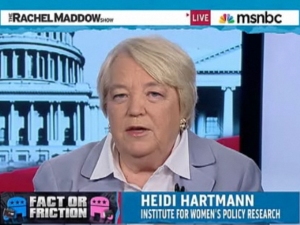We owe a debt of gratitude to MSNBC host Rachel Maddow for pointing out the differing perceptions people have about the gender wage gap. In April, she invited me on her show to set the facts straight on the wage gap and I hope that I helped her to do that
By now, most Americans are likely familiar with the 77 percent figure, meaning that, at the median, women’s wages equal only 77 percent of men’s wages both for full-time, year-round work (in 2010, the most recent year for which data are available). This figure, provided annually by the U.S. Census Bureau, has come under criticism from conservative economists and others for a variety of reasons for the past several decades—so much so, that this simple and accurate figure is now viewed by many media outlets as suspect. One New York City newspaper even refused to allow an op-ed writer to include a number such as this provided by IWPR based upon government data.
On an April 30 broadcast of the Sunday morning television show, Meet the Press, Ms. Maddow pointed out that another guest on the show, conservative-leaning CNN commentator Alex Castellanos, seemed to deny that men’s and women’s wages are unequal. After first countering that wages were equal, Mr. Castellanos said they were unequal but that was due to good reasons such as women working in fields like science or math, or women taking time off to have children, and so on. Mr. Castellanos was echoing justifications provided by conservative economists over the years to ignore the size of the wage gap by imagining that it is really much smaller than the data show, or that it may reflect women’s preferences—therefore, no government action to end discrimination is necessary.
While often those on opposite sides of an issue agree on facts but disagree on solutions, Ms. Maddow’s point is that, in terms of the wage gap, there exists a major difference in belief about the facts. In such circumstances, it is impossible to come to a compromise and agree upon a solution. Just as conservatives have spent decades challenging the role of government in regulating pollution, banks, or big business, they have spent decades challenging the popular wage gap number, and for a similar reason—to avoid policy changes. Let’s review what conservative economists have been saying.
Some economists challenge the 77 percent figure by pointing out it does not compare women’s and men’s earnings in the same jobs: in other words, the figure implicitly compares truck drivers, who are mostly male, with secretaries, who are mostly female, for example. Yes, the figure does compare women and men across the whole economy, but do we believe women should receive lower pay because they are any less talented, competent, or hard working than men? Given their equal competency, shouldn’t both women and men be able to find jobs in the economy that pay them what they’re worth?
When citing the wage gap, it may be more accurate to say, as President Obama often does, that women earn only 77 percent of what men earn for an equal day’s work (rather than for equal work).
A second set of reasons economists give for challenging the 77 percent figure is that the women and men being compared are not identical. More women than men have likely taken at least a year off from work in the past to take care of children, even if they are working full-time, year-round now. Also, more working women than working men are single parents. More married working fathers than married working mothers have stay-at-home spouses, allowing them to focus on full-time paid work.
Critics who cite these issues suggest it would be more accurate to compare single workers without children in restricted age ranges, where time spent working and work life careers are presumably more similar. But does it make sense to consider only subsets of workers? Shouldn’t women and men expect equal earnings when they provide equal effort and skill on the job whatever their age, marital, or parental status?
Yet another set of economists’ favorite reasons revolves around women’s choices. Perhaps women chose more family-friendly jobs that pay less, for example, because they provide more flexibility in exchange for the lower wages. Interestingly, data about the nature of jobs held by women and men cannot confirm this hypothesis. According to a recent survey IWPR conducted, single mothers have the least flexible jobs and college-educated white men the most flexible jobs.
Ms. Maddow was correct to point out that Mr. Castellanos is denying a reality that many women experience every day, lower pay than they deserve for the work they do. Many economists have been denying this reality for a long time. Let’s hope women’s voices and women’s votes in this election season make it clear that women’s lower wages must be addressed by stronger public policies.
Dr. Heidi Hartmann is the President of the Institute for Women’s Policy Research.
To view more of IWPR’s research, visit IWPR.org


